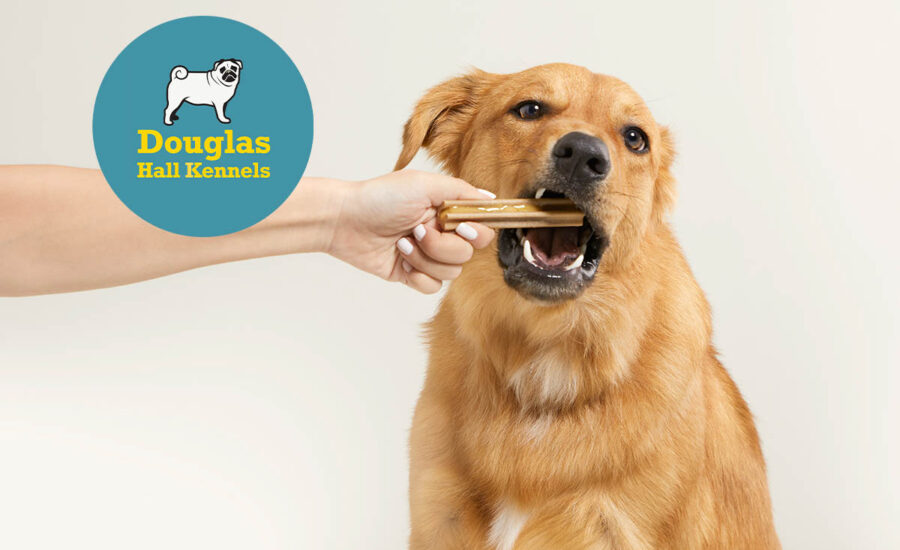When it’s not your shoes, chewing is an important activity for dogs. It helps relieve stress and anxiety, reduces plaque buildup on teeth, burns excess energy and helps ease boredom, allows puppies to explore their world and learn what is and is not appropriate to gnaw, and enables us to spot potential health concerns when chewing behavior changes.
What Is A Dog Chew?
Chews are generally consumable, durable, longer-lasting treats designed to encourage that beneficial chewing action and oh-so delicious satisfaction. (Drool puddles are a common side effect.)
Types Of Dog Chews
Like dogs, no chew is created equal. Where some chews switch on the drool faucet and disappear in seconds, others get tails and tongues wagging for a jaw-flexing challenge. Whichever your dog prefers, all chews—whether soft and chewy or strong and solid—should be given with care and caution.
Hard chews like natural bones (cooked or raw), antlers, yak chews, rawhide, bully sticks, beef tracheas, dried hooves, and even ice cubes can cause tooth fractures and micro-fractures, something vets see all too often and dog parents anticipate all too infrequently. They can also cause other kinds of injuries if they splinter in the mouth or develop sharp edges over time.
While softer chews present less risk for injuries like tooth fractures, some dogs find them all too easy to break down and swallow. Ingesting large pieces can lead to gastrointestinal upset or an emergency intestinal obstruction.
Dog Chews & Dog Size
Always choose a chew best suited to your dog’s size, and supervise! Dogs should be able to easily grip and hold the chew, and it should be large enough that chunks cannot be bitten off and swallowed, creating a potential choking hazard or intestinal blockage.
Once the chew has been gnawed down small enough to fit entirely in the mouth, it’s time to take away and toss. (And if your dog is part shark and frequently tears off too-big bites, chews in general are not a safe choice for them.)
How To Give Your Dog A Chew
- Ensure that the chew is not too large or too small for your dog—they should be able to hold it between their paws and not remove large chunks that may be swallowed without chewing.
- Like any treat, chews are best given in moderation. They’re great choices when your dog is in need of a little extra mental stimulation, like on rainy days or when it’s too hot to play outside, but they’re an even better complementary activity (like in your monthly BarkBox delivery!) to maintain a balanced lifestyle. Without plenty of exercise and mental workouts (like training, socialization, and human interaction), chewing can become obsessive. As a result, potentially dangerous habits, such as gulping, too-hard chewing, and resource guarding can develop.
Also note: Any edible chew or treat contains calories that need to be counted to maintain a healthy weight. No supplemental chew should exceed more than 10% of your dog’s daily caloric intake (no matter how much they beg).
- Always supervise! For example, never give a chew to your dog in their crate before you leave. Be sure to provide fresh water, and prepare to remove too-small pieces to avoid choking, tummy upset, or intestinal obstruction.
- See a veterinarian immediately if you notice any unusual behavior after your dog consumes a chew, including vomiting or non-productive retching.
See Also: 5 Benefits Of Chewing Your Dog Needs You To Know
Dog Chew Safety Precautions
Keep a close eye on your dog with any treat, chew, or toy. If your dog is a natural treat-guzzler, treat-dispensing toys or toys in which you can add spreadable treats and freeze, like many Super Chewer toys, are a safer, but still mentally stimulating alternative.
Tougher chews like raw bones, antlers, and natural bones may help prevent dogs from swallowing large chunks, but remember that the harder the chew, the higher the risk for dental injuries like cracked teeth. Raw bones or food also present the added risk of food-borne disease that can seriously affect both you and your dog.
The Fingernail Test
The “fingernail test” is helpful—if you can make an indentation with your fingernail, the chew should be soft enough to play nice with those eager chompers. It may also have enough give to allow it to be broken or bent easily by hand. If it’s not, use your best judgement and remove the chew after 10–15 minutes to allow for short breaks. When a chew becomes small enough to fit inside the mouth, it’s time to discard.
If your dog has a tendency to consume softer chews at the speed of light, you may need to balance the risk of fractured teeth (a longer-lasting hard chew) against the risk of intestinal obstruction (a short-lived soft chew).
How To Spot A Dental Injury
Dogs need healthy, intact teeth to chew appropriately and safely. Just like humans, they require regular visits to a veterinary dentist for a full assessment, and should engage in daily preventative dental care. This toothbrush-free dental kit from BARK Bright pairs a triple-enzymatic toothpaste with a no-mess dental chew to get the job done in a way dogs actually enjoy!
Dogs with loose or fractured teeth should not chew on treats or toys, and may even have trouble eating kibble properly without obvious discomfort. If they suddenly appear uninterested in chewing, or let food drop out of their mouth as they eat, it could be a possible indication of a new dental issue (like a tooth fracture) that requires vet attention.

